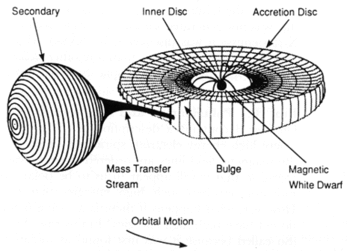DQ Herculis star
DQ Herculis stars ( Intermediate polars ( abbr.IPs )) together with the AM Herculis stars form the class of magnetic cataclysmic variables (abbreviation mCVs), in which the accretion geometry of the mass transfer due to the strong magnetic field of the white dwarf is greatly changed. The mass transfer to the white dwarf takes place, as is generally the case in cataclysmic variables, from a low-mass main sequence star that fills its Roche volume.
In contrast to the AM Herculis stars, the magnetic field strength of the white dwarf is lower (<10 megagauss ), so that it can rotate freely and, as a rule, the formation of an accretion disk is not prevented. The accretion rates, which are significantly higher than those of the AM Herculis stars, also prevent spin-orbit coupling or, through angular momentum transfer, lead to very short periods of rotation of the white dwarf (e.g. 33 seconds for AE Aqr ).
The accretion on the surface of the white dwarf takes place along the magnetic field lines, where the gaseous matter couples from the inner edge of the accretion disk. Upon radial impact on the white dwarf, a plasma of several million Kelvin arises in a compact accretion region several hundred kilometers in size. The luminosity of up to 10 33 ergs per second emitted there is mainly released as hard X-ray braking radiation in the range of 6 to 10 keV . If the axis of rotation is inclined with respect to the magnetic poles, a pulsating X-ray source occurs. Infrared and optical cyclotron radiation , as well as their polarization , are difficult to detect in these objects, as the radiation from the accretion disk dominates in the specified spectral ranges with a continuum interspersed with emission lines with double pairs. The variability both in the optical and in the X-ray range is associated with a variable mass transfer rate and the interaction in the magnetosphere of the white dwarf. Short-term flares are interpreted as a result of thermonuclear explosions on the surface of the compact star .
The orbit periods of the approx. 90 known DQ Herculis stars are on average longer than those of the AM Herculis stars and are usually above the period gap of the cataclysmic variable of 3 hours. The white dwarfs in the DQ Herculis stars have rotation periods between 33 seconds and 67 minutes. There is a rough correlation between the rotation period and the orbit period, with the rotation period usually being shorter than 1/10 of the orbit period. However, the magnetic field densities of the polar and DQ Herculis stars overlap. It is believed that most of the DQ Herculis stars with strong magnetic fields transform into polars after the orbit of the binary star system has shortened to values of less than 3 hours. In contrast, DQ Herculis stars with magnetic moments of less than 5 × 10 33 Gcm 3 should not synchronize the period of rotation of the white dwarf and the period of rotation of the binary star system.
Some of the DQ Herculis stars were once super-soft X-ray sources that converted the accreted matter into helium in a constant hydrogen burn on the surface of the white dwarf. During this phase of continuous accretion, the period of rotation of the white dwarf has also accelerated to the values observed in DQ Herculis stars of a few tens of seconds to a few minutes. The IPs are often unable to accret all of the matter flowing onto the white dwarf. This is known as the propeller mechanism, in which the accretion current is split up into fireballs and only a small part of these can overcome the rapidly rotating magnetic field bound to the white dwarf. The largest part, often more than 90%, is accelerated out of the binary star system by the propeller . If one of the fireballs overcomes the magnetic field and is accreted onto the white dwarf, this leads to a flare . The gas fireballs from the companion star have a typical diameter of 10,000 km and a mass of 10-14 tons at temperatures around 20,000 K.
Well-known DQ Herculis stars
See also
Individual evidence
- ^ Patterson J .: The DQ Herculis stars . In: Publications of the Astronomical Society of the Pacific . 106, 1994, p. 209. bibcode : 1994PASP..106..209P . doi : 10.1086 / 133375 .
- ^ B. Warner: Cataclysmic variable stars , 1995, ISBN 0-521-41231-5
- ^ Cuno Hoffmeister , G. Richter, W. Wenzel: Veränderliche Sterne . JA Barth Verlag., Leipzig 1990, ISBN 3-335-00224-5
- ↑ NR Ikhsanov and NG Beskrovnaya: AE Aquarii darstellt a new subclass of Cataclysmic Variables . In: Astrophysics. Solar and Stellar Astrophysics . 2012, arxiv : 1205.4330v1 .
- ↑ List of known DQ Herculis stars
- ↑ A. Aungwerojwit, BT Gänsicke, PJ Wheatley, S.Pyrzas, B. Staels, T. Krajci, P. Rodríguez-Gil: IPHAS J062746.41 + 014811.3: a deeply eclipsing intermediate polar . In: Astrophysics. Solar and Stellar Astrophysics . 2012, arxiv : 1209.0719 .
- ↑ RK Zamanov, GY Latev, KA Stoyanov, S. Boeva, B. Spassov, SV Tsvetkova: Simultaneous UBVRI observations of the cataclysmic variable AE Aquarii: temperature and mass of fireballs . In: Astrophysics. Solar and Stellar Astrophysics . 2012, arxiv : 1208.2834 .
